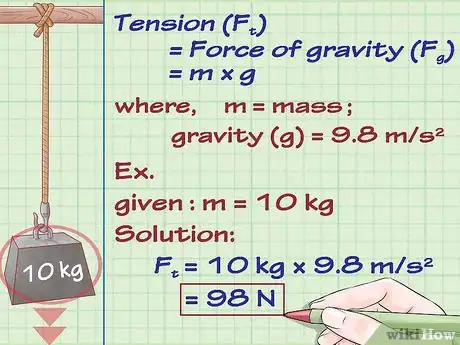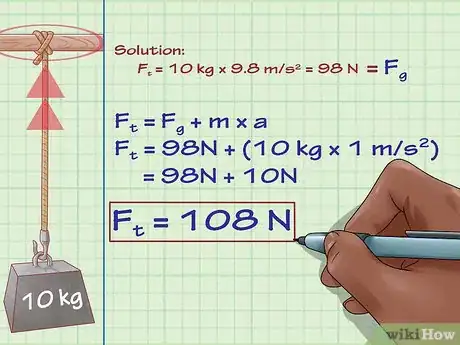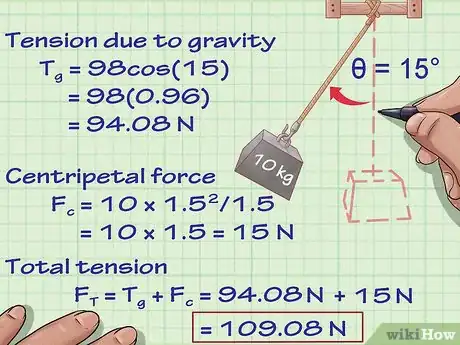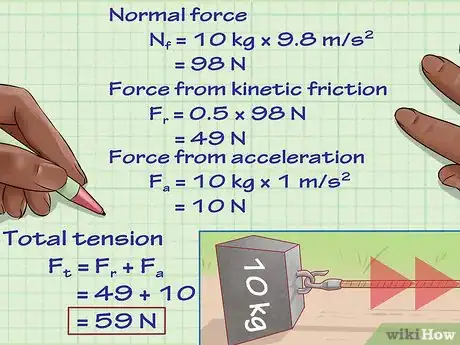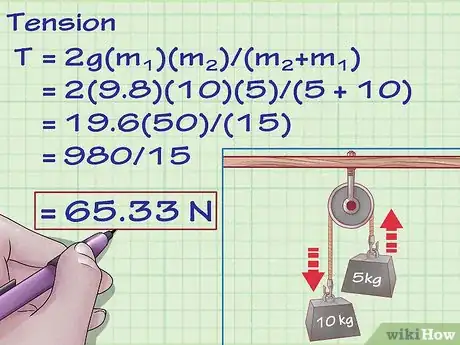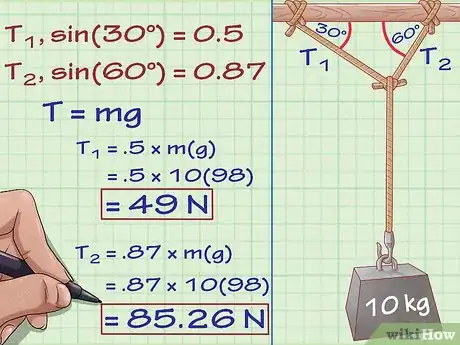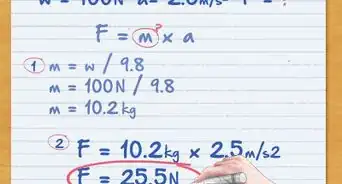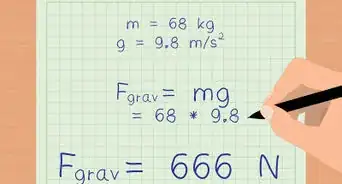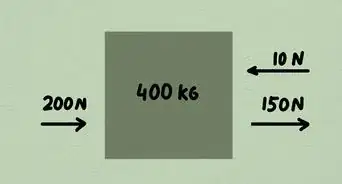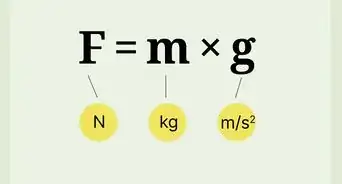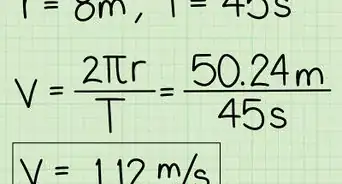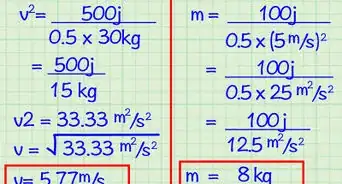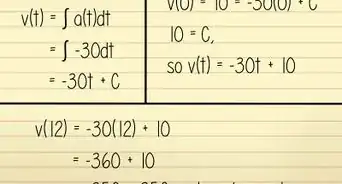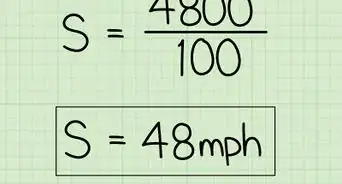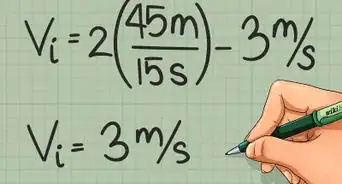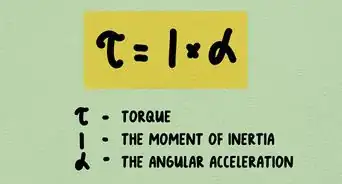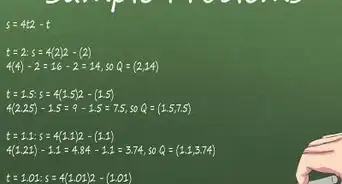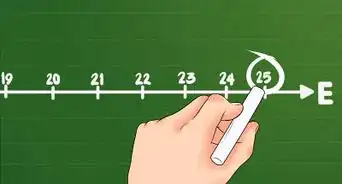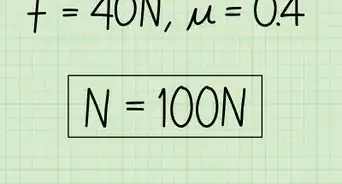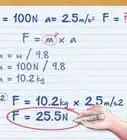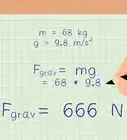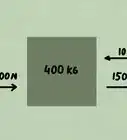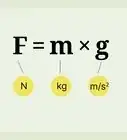This article was co-authored by Bess Ruff, MA. Bess Ruff is a Geography PhD student at Florida State University. She received her MA in Environmental Science and Management from the University of California, Santa Barbara in 2016. She has conducted survey work for marine spatial planning projects in the Caribbean and provided research support as a graduate fellow for the Sustainable Fisheries Group.
There are 7 references cited in this article, which can be found at the bottom of the page.
wikiHow marks an article as reader-approved once it receives enough positive feedback. This article has 16 testimonials from our readers, earning it our reader-approved status.
This article has been viewed 1,949,148 times.
In physics, tension is the force exerted by a rope, string, cable, or similar object on one or more objects. Anything pulled, hung, supported, or swung from a rope, string, cable, etc. is subject to the force of tension.[1] Like all forces, tension can accelerate objects or cause them to deform. Being able to calculate tension is an important skill not just for physics students but also for engineers and architects, who, to build safe buildings, must know whether the tension on a given rope or cable can withstand the strain caused by the weight of the object before yielding and breaking. See Step 1 to learn how to calculate tension in several physical systems.
Steps
Determining Tension On a Single Strand
-
1Define the forces on either end of the strand. The tension in a given strand of string or rope is a result of the forces pulling on the rope from either end. As a reminder, force = mass × acceleration. Assuming the rope is stretched tightly, any change in acceleration or mass in objects the rope is supporting will cause a change in tension in the rope. Don't forget the constant acceleration due to gravity - even if a system is at rest, its components are subject to this force. We can think of a tension in a given rope as T = (m × g) + (m × a), where "g" is the acceleration due to gravity of any objects the rope is supporting and "a" is any other acceleration on any objects the rope is supporting.[2]
- For the purposes of most physics problems, we assume ideal strings - in other words, that our rope, cable, etc. is thin, massless, and can't be stretched or broken.
- As an example, let's consider a system where a weight hangs from a wooden beam via a single rope (see picture). Neither the weight nor the rope are moving - the entire system is at rest. Because of this, we know that, for the weight to be held in equilibrium, the tension force must equal the force of gravity on the weight. In other words, Tension (Ft) = Force of gravity (Fg) = m × g.
- Assuming a 10 kg weight, then, the tension force is 10 kg × 9.8 m/s2 = 98 Newtons.
-
2Account for acceleration after defining the forces. Gravity isn't the only force that can affect the tension in a rope - so can any force related to acceleration of an object the rope is attached to. If, for instance, a suspended object is being accelerated by a force on the rope or cable, the acceleration force (mass × acceleration) is added to the tension caused by the weight of the object.
- Let's say that, in our example of the 10 kg weight suspended by a rope, that, instead of being fixed to a wooden beam, the rope is actually being used to pull the weight upwards at an acceleration of 1 m/s2. In this case, we must account for the acceleration on the weight as well as the force of gravity by solving as follows:
- Ft = Fg + m × a
- Ft = 98 + 10 kg × 1 m/s2
- Ft = 108 Newtons.
Advertisement - Let's say that, in our example of the 10 kg weight suspended by a rope, that, instead of being fixed to a wooden beam, the rope is actually being used to pull the weight upwards at an acceleration of 1 m/s2. In this case, we must account for the acceleration on the weight as well as the force of gravity by solving as follows:
-
3Account for rotational acceleration. An object being rotated around a central point via a rope (like a pendulum) exerts strain on the rope caused by centripetal force. Centripetal force is the added tension force the rope exerts by "pulling" inward to keep an object moving in its arc and not in a straight line. The faster the object is moving, the greater the centripetal force. Centripetal force (Fc) is equal to m × v2/r where "m" is mass, "v" is velocity, and "r" is the radius of the circle that contains the arc of the object's motion.[3]
- Since the direction and magnitude of centripetal force changes as the object on the rope moves and changes speeds, so does the total tension in the rope, which always pulls parallel to the rope towards the central point. Remember also that the force of gravity is constantly acting on the object in a downward direction. So, if an object is being spun or swung vertically, total tension is greatest at the bottom of the arc (for a pendulum, this is called the equilibrium point) when the object is moving fastest and least at the top of the arc when it is moving slowest.[4]
- Let's say in our example problem that our object is no longer accelerating upwards but instead is swinging like a pendulum. We'll say that our rope is 1.5 meters (4.9 ft) long and that our weight is moving at 2 m/s when it passes through the bottom of its swing. If we want to calculate tension at the bottom of the arc when it's highest, we would first recognize that the tension due to gravity at this point is the same as when the weight was held motionless - 98 Newtons.To find the additional centripetal force, we would solve as follows:
- Fc = m × v2/r
- Fc = 10 × 22/1.5
- Fc =10 × 2.67 = 26.7 Newtons.
- So, our the total tension would be 98 + 26.7 = 124.7 Newtons.
-
4Understand that tension due to gravity changes throughout a swinging object's arc. As noted above, both the direction and magnitude of centripetal force change as an object swings. However, though the force of gravity remains constant, the tension resulting from gravity also changes. When a swinging object isn't at the bottom of its arc (its equilibrium point), gravity is pulling directly downward, but tension is pulling up at an angle. Because of this, tension only has to counteract part of the force due to gravity, rather than its entirety.
- Breaking gravitational force up into two vectors can help you visualize this concept. At any given point in the arc of a vertically swinging object, the rope forms an angle "θ" with the line through the equilibrium point and the central point of rotation. As the pendulum swings, gravitational force (m × g) can be broken up into two vectors - mgsin(θ) acting tangent to the arc in the direction of the equilibrium point and mgcos(θ) acting parallel to the tension force in the opposite direction. Tension only has to counter mgcos(θ) - the force pulling against it - not the entire gravitational force (except at the equilibrium point, when these are equal).
- Let's say that when our pendulum forms an angle of 15 degrees with the vertical, it's moving 1.5 m/s. We would find tension by solving as follows:
- Tension due to gravity (Tg) = 98cos(15) = 98(0.96) = 94.08 Newtons
- Centripetal force (Fc) = 10 × 1.52/1.5 = 10 × 1.5 = 15 Newtons
- Total tension = Tg + Fc = 94.08 + 15 = 109.08 Newtons.
-
5Account for friction. Any object being pulled by a rope that experiences a "drag" force from friction against another object (or fluid) transfers this force to the tension in the rope. Force from friction between two objects is calculated as it would be in any other situation - via the following equation: Force due to friction (usually written Fr) = (mu)N, where mu is the friction coefficient between the two objects and N is the normal force between the two objects, or the force with which they are pressing into each other. Note that static friction - the friction that results when trying to put a stationary object into motion - is different than kinetic friction - the friction that results when trying to keep a moving object in motion.
- Let's say that our 10 kg weight is no longer being swung but is now being dragged horizontally along the ground by our rope. Let's say that the ground has a kinetic friction coefficient of 0.5 and that our weight is moving at a constant velocity but that we want to accelerate it at 1 m/s2. This new problem presents two important changes - first, we no longer have to calculate tension due to gravity because our rope isn't supporting the weight against its force. Second, we have to account for tension caused by friction, as well as that caused by accelerating the weight's mass. We would solve as follows:
- Normal force (N) = 10 kg × 9.8 (acceleration from gravity) = 98 N
- Force from kinetic friction (Fr) = 0.5 × 98 N = 49 Newtons
- Force from acceleration (Fa) = 10 kg × 1 m/s2 = 10 Newtons
- Total tension = Fr + Fa = 49 + 10 = 59 Newtons.
- Let's say that our 10 kg weight is no longer being swung but is now being dragged horizontally along the ground by our rope. Let's say that the ground has a kinetic friction coefficient of 0.5 and that our weight is moving at a constant velocity but that we want to accelerate it at 1 m/s2. This new problem presents two important changes - first, we no longer have to calculate tension due to gravity because our rope isn't supporting the weight against its force. Second, we have to account for tension caused by friction, as well as that caused by accelerating the weight's mass. We would solve as follows:
Calculating Tensions On Multiple Strands
-
1Lift parallel vertical loads using a pulley. Pulleys are simple machines consisting of a suspended disk that allows the tension force in a rope to change direction. In a simple pulley configuration, the rope or cable runs from a suspended weight up to the pulley, then down to another, creating 2 lengths of rope or cable strands. However, the tension in both sections of rope is equal, even if both ends of the rope are being pulled by forces of different magnitudes. For a system of two masses hanging from a vertical pulley, tension equals 2g(m1)(m2)/(m2+m1), where "g" is the acceleration of gravity, "m1" is the mass of object 1, and "m2" is the mass of object 2.[5]
- Note that, usually, physics problems assume ideal pulleys - massless, frictionless pulleys that can't break, deform, or become separated from the ceiling, rope, etc. that supports them.
- Let's say we have two weights hanging vertically from a pulley in parallel strands. Weight 1 has a mass of 10 kg, while weight 2 has a mass of 5 kg. In this case, we would find tension as follows:
- T = 2g(m1)(m2)/(m2+m1)
- T = 2(9.8)(10)(5)/(5 + 10)
- T = 19.6(50)/(15)
- T = 980/15
- T = 65.33 Newtons.
- Note that, because one weight is heavier than the other, all other things being equal, this system will begin to accelerate, with the 10 kg moving downward and the 5 kg weight moving upward.
-
2Lift loads using a pulley with non-parallel vertical strands. Pulleys are often used to direct tension in a direction other than up or down. If, for instance, a weight is suspended vertically from one end of the rope while the other end is attached to a second weight on a diagonal slope, the non-parallel pulley system takes the shape of a triangle with points at the first weight, the second weight, and the pulley. In this case, the tension in the rope is affected both by the force of gravity on the weight and by the component of the pulling force that's parallel to the diagonal section of rope.[6]
- Let's say we have a system with a 10 kg weight (m1) hanging vertically connected by a pulley to a 5 kg weight (m2) on a 60 degree ramp (assume the ramp is frictionless).To find the tension in the rope, it's easiest to find equations for the forces accelerating the weights first. Proceed as follows:
- The hanging weight is heavier and we're not dealing with friction, so we know it will accelerate downward. The tension in the rope is pulling up on it, though, so it's accelerating due to the net force F = m1(g) - T, or 10(9.8) - T = 98 - T.
- We know the weight on the ramp will accelerate up the ramp. Since the ramp is frictionless, we know that the tension is pulling it up the ramp and only its own weight is pulling it down. The component of the force pulling it down the ramp is given by sin(θ), so, in our case, we can say that it's accelerating up the ramp due to the net force F = T - m2(g)sin(60) = T - 5(9.8)(.87) = T - 42.63.[7]
- Acceleration of the two weights are the same, thus we have (98 - T)/m1 = (T - 42.63) /m2. After a little trivial work to solve this equation, finally we have T = 60.96 Newton.
- Let's say we have a system with a 10 kg weight (m1) hanging vertically connected by a pulley to a 5 kg weight (m2) on a 60 degree ramp (assume the ramp is frictionless).To find the tension in the rope, it's easiest to find equations for the forces accelerating the weights first. Proceed as follows:
-
3Use multiple strands to support a hanging object. Finally, let's consider an object hanging from a "Y-shaped" system of ropes - two ropes are attached to the ceiling, which meet at a central point from which a weight hangs by a third rope. The tension in the third rope is obvious - it's simply tension resulting from the gravitational force, or m(g). The tensions in the other two ropes are different and must add up to equal the gravitational force in the upward vertical direction and to equal zero in either horizontal direction, assuming the system is at rest. The tension in the ropes is affected both by the mass of the hanging weight and by the angle at which each rope meets the ceiling.[8]
- Let's say in our Y-shaped system that the bottom weight has a mass of 10 kg and that the two upper ropes meet the ceiling at 30 degrees and 60 degrees respectively. If we want to find the tension in each of the upper ropes, we'll need to consider each tension's vertical and horizontal components. Nonetheless, in this example, the two ropes happens to be perpendicular to each other, making it easy for us to calculate according to the definitions of trigonometric functions as follows:
- The ratio between T1 or T2 and T = m(g) is equal to the sine of the angle between each supporting rope and the ceiling. For T1, sin(30) = 0.5, while for T2, sin(60) = 0.87
- Multiply the tension in the lower rope (T = mg) by the sine of each angle to find T1 and T2.
- T1 = .5 × m(g) = .5 × 10(9.8) = 49 Newtons.
- T2 = .87 × m(g) = .87 × 10(9.8) = 85.26 Newtons.
- Let's say in our Y-shaped system that the bottom weight has a mass of 10 kg and that the two upper ropes meet the ceiling at 30 degrees and 60 degrees respectively. If we want to find the tension in each of the upper ropes, we'll need to consider each tension's vertical and horizontal components. Nonetheless, in this example, the two ropes happens to be perpendicular to each other, making it easy for us to calculate according to the definitions of trigonometric functions as follows:
Expert Q&A
-
QuestionWhat will the dimension of tension be?
 Bess Ruff, MABess Ruff is a Geography PhD student at Florida State University. She received her MA in Environmental Science and Management from the University of California, Santa Barbara in 2016. She has conducted survey work for marine spatial planning projects in the Caribbean and provided research support as a graduate fellow for the Sustainable Fisheries Group.
Bess Ruff, MABess Ruff is a Geography PhD student at Florida State University. She received her MA in Environmental Science and Management from the University of California, Santa Barbara in 2016. She has conducted survey work for marine spatial planning projects in the Caribbean and provided research support as a graduate fellow for the Sustainable Fisheries Group.
Environmental Scientist Tension is measured in Newtons.
Tension is measured in Newtons. -
QuestionWhat is the main formula for tension?
 Bess Ruff, MABess Ruff is a Geography PhD student at Florida State University. She received her MA in Environmental Science and Management from the University of California, Santa Barbara in 2016. She has conducted survey work for marine spatial planning projects in the Caribbean and provided research support as a graduate fellow for the Sustainable Fisheries Group.
Bess Ruff, MABess Ruff is a Geography PhD student at Florida State University. She received her MA in Environmental Science and Management from the University of California, Santa Barbara in 2016. She has conducted survey work for marine spatial planning projects in the Caribbean and provided research support as a graduate fellow for the Sustainable Fisheries Group.
Environmental Scientist Tension (Ft) = Force of gravity (Fg) = m × g
Tension (Ft) = Force of gravity (Fg) = m × g -
QuestionDoes tension always act in the opposite direction of an applied force?
 Community AnswerThis is one of Newton's laws! It doesn't just apply to tension, but to ANY force on an object, there is an equal force in the opposite direction. In the case of tension, it can only act in the direction parallel to the object it is in (like a rope or truss member).
Community AnswerThis is one of Newton's laws! It doesn't just apply to tension, but to ANY force on an object, there is an equal force in the opposite direction. In the case of tension, it can only act in the direction parallel to the object it is in (like a rope or truss member).
References
- ↑ https://www.khanacademy.org/science/physics/forces-newtons-laws/tension-tutorial/a/what-is-tension
- ↑ https://www.softschools.com/formulas/physics/tension_formula/70/
- ↑ https://www.youtube.com/watch?v=4E9oRrmngDU
- ↑ https://www.youtube.com/watch?v=4E9oRrmngDU
- ↑ https://www.khanacademy.org/science/physics/forces-newtons-laws/treating-systems/v/two-masses-hanging-from-a-pulley
- ↑ http://hyperphysics.phy-astr.gsu.edu/hbase/incpl.html
- ↑ http://hyperphysics.phy-astr.gsu.edu/hbase/incpl.html
- ↑ https://www.youtube.com/watch?v=6OAlb5F3NEE
- http://dev.physicslab.org/Document.aspx?doctype=3&filename=OscillatoryMotion_VerticalCircles.xml
About This Article
To calculate the tension on a rope holding 1 object, multiply the mass and gravitational acceleration of the object. If the object is experiencing any other acceleration, multiply that acceleration by the mass and add it to your first total. To calculate the tension when a pulley is lifting 2 loads vertically, multiply gravity time 2, then multiply it by both masses. Divide that by the combined mass of both objects. When you’re done, remember to write your answer in Newtons! For examples and formulas for different situations, read on!
